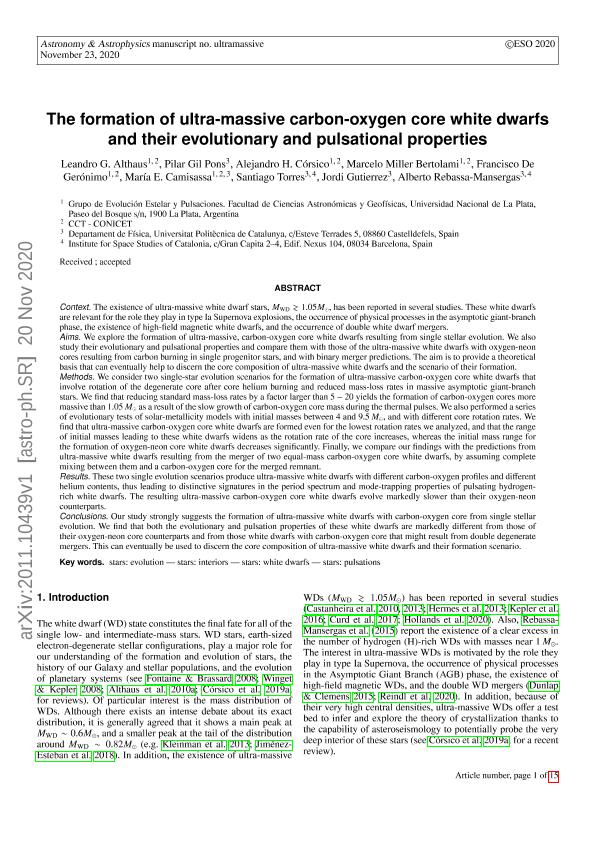Mostrar el registro sencillo del ítem
dc.contributor.author
Althaus, Leandro Gabriel

dc.contributor.author
Pons, Pilar Gi
dc.contributor.author
Corsico, Alejandro Hugo

dc.contributor.author
Miller Bertolami, Marcelo Miguel

dc.contributor.author
de Gerónimo, Francisco César

dc.contributor.author
Camisassa, María Eugenia

dc.contributor.author
Torres, Santiago
dc.contributor.author
Gutierrez, Jordi
dc.contributor.author
Rebassa Mansergas, Alberto
dc.date.available
2021-10-28T17:20:49Z
dc.date.issued
2021-02
dc.identifier.citation
Althaus, Leandro Gabriel; Pons, Pilar Gi; Corsico, Alejandro Hugo; Miller Bertolami, Marcelo Miguel; de Gerónimo, Francisco César; et al.; The formation of ultra-massive carbon-oxygen core white dwarfs and their evolutionary and pulsational properties; EDP Sciences; Astronomy and Astrophysics; 646; 2-2021; 1-15
dc.identifier.issn
0004-6361
dc.identifier.uri
http://hdl.handle.net/11336/145377
dc.description.abstract
Context. The existence of ultra-massive white dwarf stars, MWD & 1.05 M, has been reported in several studies. These white dwarfs are relevant for the role they play in type Ia supernova explosions, the occurrence of physical processes in the asymptotic giant-branch phase, the existence of high-field magnetic white dwarfs, and the occurrence of double-white-dwarf mergers. Aims. We aim to explore the formation of ultra-massive, carbon-oxygen core white dwarfs resulting from single stellar evolution. We also intend to study their evolutionary and pulsational properties and compare them with those of the ultra-massive white dwarfs with oxygen-neon cores resulting from carbon burning in single progenitor stars, and with binary merger predictions. The aim is to provide a theoretical basis that can eventually help to discern the core composition of ultra-massive white dwarfs and the circumstances of their formation. Methods. We considered two single-star evolution scenarios for the formation of ultra-massive carbon-oxygen core white dwarfs, which involve the rotation of the degenerate core after core helium burning and reduced mass-loss rates in massive asymptotic giant-branch stars. We find that reducing standard mass-loss rates by a factor larger than 5−20 yields the formation of carbon-oxygen cores more massive than 1.05 M as a result of the slow growth of carbon-oxygen core mass during the thermal pulses. We also performed a series of evolutionary tests of solar-metallicity models with initial masses between 4 and 9.5 M and with different core rotation rates. We find that ultra-massive carbon-oxygen core white dwarfs are formed even for the lowest rotation rates we analyzed, and that the range of initial masses leading to these white dwarfs widens as the rotation rate of the core increases, whereas the initial mass range for the formation of oxygen-neon core white dwarfs decreases significantly. Finally, we compared our findings with the predictions from ultra-massive white dwarfs resulting from the merger of two equal-mass carbon-oxygen core white dwarfs, by assuming complete mixing between them and a carbon-oxygen core for the merged remnant. Results. These two single-evolution scenarios produce ultra-massive white dwarfs with different carbon-oxygen profiles and different helium contents, thus leading to distinctive signatures in the period spectrum and mode-trapping properties of pulsating hydrogen-rich white dwarfs. The resulting ultra-massive carbon-oxygen core white dwarfs evolve markedly slower than their oxygen-neon counterparts. Conclusions. Our study strongly suggests the formation of ultra-massive white dwarfs with carbon-oxygen cores from a single stellar evolution. We find that both the evolutionary and pulsation properties of these white dwarfs are markedly different from those of their oxygen-neon core counterparts and from those white dwarfs with carbon-oxygen cores that might result from double-degenerate mergers. This can eventually be used to discern the core composition of ultra-massive white dwarfs and their formation scenario.
dc.format
application/pdf
dc.language.iso
eng
dc.publisher
EDP Sciences

dc.rights
info:eu-repo/semantics/openAccess
dc.rights.uri
https://creativecommons.org/licenses/by-nc-sa/2.5/ar/
dc.subject
STARS: EVOLUTION
dc.subject
STARS: INTERIORS
dc.subject
STARS: OSCILLATIONS
dc.subject
WHITE DWARFS
dc.subject.classification
Astronomía

dc.subject.classification
Ciencias Físicas

dc.subject.classification
CIENCIAS NATURALES Y EXACTAS

dc.title
The formation of ultra-massive carbon-oxygen core white dwarfs and their evolutionary and pulsational properties
dc.type
info:eu-repo/semantics/article
dc.type
info:ar-repo/semantics/artículo
dc.type
info:eu-repo/semantics/publishedVersion
dc.date.updated
2021-07-01T14:25:49Z
dc.identifier.eissn
1432-0746
dc.journal.volume
646
dc.journal.pagination
1-15
dc.journal.pais
Francia

dc.journal.ciudad
Paris
dc.description.fil
Fil: Althaus, Leandro Gabriel. Consejo Nacional de Investigaciones Científicas y Técnicas. Centro Científico Tecnológico Conicet - La Plata. Instituto de Astrofísica La Plata. Universidad Nacional de La Plata. Facultad de Ciencias Astronómicas y Geofísicas. Instituto de Astrofísica La Plata; Argentina
dc.description.fil
Fil: Pons, Pilar Gi. Universidad Politécnica de Catalunya; España
dc.description.fil
Fil: Corsico, Alejandro Hugo. Consejo Nacional de Investigaciones Científicas y Técnicas. Centro Científico Tecnológico Conicet - La Plata. Instituto de Astrofísica La Plata. Universidad Nacional de La Plata. Facultad de Ciencias Astronómicas y Geofísicas. Instituto de Astrofísica La Plata; Argentina
dc.description.fil
Fil: Miller Bertolami, Marcelo Miguel. Consejo Nacional de Investigaciones Científicas y Técnicas. Centro Científico Tecnológico Conicet - La Plata. Instituto de Astrofísica La Plata. Universidad Nacional de La Plata. Facultad de Ciencias Astronómicas y Geofísicas. Instituto de Astrofísica La Plata; Argentina
dc.description.fil
Fil: de Gerónimo, Francisco César. Consejo Nacional de Investigaciones Científicas y Técnicas. Centro Científico Tecnológico Conicet - La Plata. Instituto de Astrofísica La Plata. Universidad Nacional de La Plata. Facultad de Ciencias Astronómicas y Geofísicas. Instituto de Astrofísica La Plata; Argentina
dc.description.fil
Fil: Camisassa, María Eugenia. Consejo Nacional de Investigaciones Científicas y Técnicas. Centro Científico Tecnológico Conicet - La Plata. Instituto de Astrofísica La Plata. Universidad Nacional de La Plata. Facultad de Ciencias Astronómicas y Geofísicas. Instituto de Astrofísica La Plata; Argentina. Universidad Politécnica de Catalunya; España
dc.description.fil
Fil: Torres, Santiago. Universidad Politécnica de Catalunya; España. Institute for Space Studies of Catalonia; España
dc.description.fil
Fil: Gutierrez, Jordi. Universidad Politécnica de Catalunya; España
dc.description.fil
Fil: Rebassa Mansergas, Alberto. Universidad Politécnica de Catalunya; España. Institute for Space Studies of Catalonia; España
dc.journal.title
Astronomy and Astrophysics

dc.relation.alternativeid
info:eu-repo/semantics/altIdentifier/doi/http://dx.doi.org/10.1051/0004-6361/202038930
dc.relation.alternativeid
info:eu-repo/semantics/altIdentifier/url/https://www.aanda.org/articles/aa/abs/2021/02/aa38930-20/aa38930-20.html
dc.relation.alternativeid
info:eu-repo/semantics/altIdentifier/url/https://arxiv.org/abs/2011.10439
Archivos asociados
